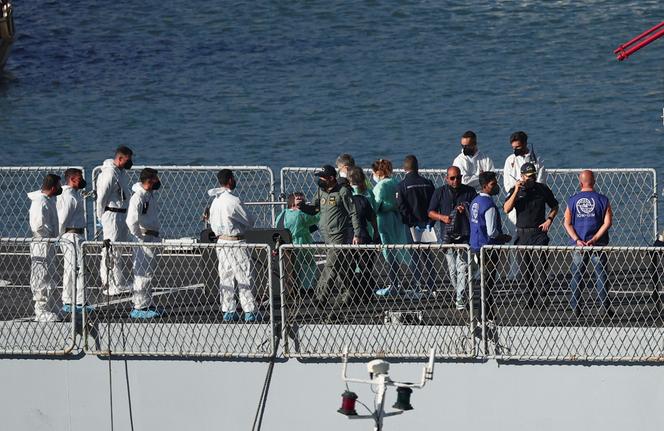

Less than a year after the signing of a controversial agreement between Rome and Tirana, the first migrants caught in Italian waters have arrived in Albania. Outsourced asylum requests have never been seen in Europe.
Shortly before 8 a.m., the ship Libra The Italian Navy arrives at the port of Shëngjin, in northern Albania. In it, sixteen men from Egypt and Bangladesh, Italian law enforcement, and a man in a white jumpsuit. Their journey lasted more than thirty-six hours. About fifteen people were waiting for them upon arrival, journalists from Agence France-Presse noted, despite a total ban on entering the port.
Once disembarked, the sixteen men would be enrolled in the first center created by the Italians in Albania, a prefabricated unit set up in a harbor surrounded by high gates and guarded by Italian law enforcement. They will then be taken 20 kilometers to Gjadër camp.
There, installed in a 12-square-meter prefab house, also surrounded by high walls, and monitored by cameras and members of Italian law enforcement, they will be able to apply for asylum. If they refuse, they will be placed in cells set up in the camp, while waiting to be repatriated to their home countries.
An agreement criticized by NGOs
This outsourcing of asylum requests, the first in Europe, was made possible by a controversial agreement signed in November 2023 between the head of the Italian government, Giorgia Meloni (far right), and the Prime Minister of Albania, Edi Rama (socialist), in the name of the long relationship uniting the two countries . This only concerns adult males intercepted by the Italian Navy or Coast Guard in their search and rescue zones in international waters.
The procedure provides for an initial inspection of the military vessel, before its transfer to Shëngjin, for identification, then to the former military base in Gjadër. The centers should have a capacity of one thousand places initially, then three thousand places eventually. Lasting five years, the cost to Italy is estimated at 160 million euros per year.
Greetings Tuesday a « according to courage »Giorgia Meloni is what you also said “proud that Italy has become an example to follow from this point of view” – aroused the interest of the governments of France, Germany, Sweden and the UK in Italy’s policy in managing migration flows.
The agreement was criticized by many human rights NGOs who saw it as a violation of international rules. “The Italy-Albania agreement violates international maritime law and risks further eroding refugees’ basic rights”wrote the NGO SOS Humanity on Tuesday, predicting just that “Italy de facto detains people seeking refuge on Albanian territory without review, which is highly inhumane and violates their basic rights. (…). This agreement is a new strategy for a European Union Member State [UE] aims to outsource migration management and thereby divest itself of responsibility for the human rights of refugees.”
Earlier this week, the President of the European Commission, Ursula von der Leyen, mentioned, in a letter to EU member states, a flammable proposal to transfer migrants to reception centers in third countries, « hub to return »call to withdraw « lekon » Italian-Albanian agreement.





